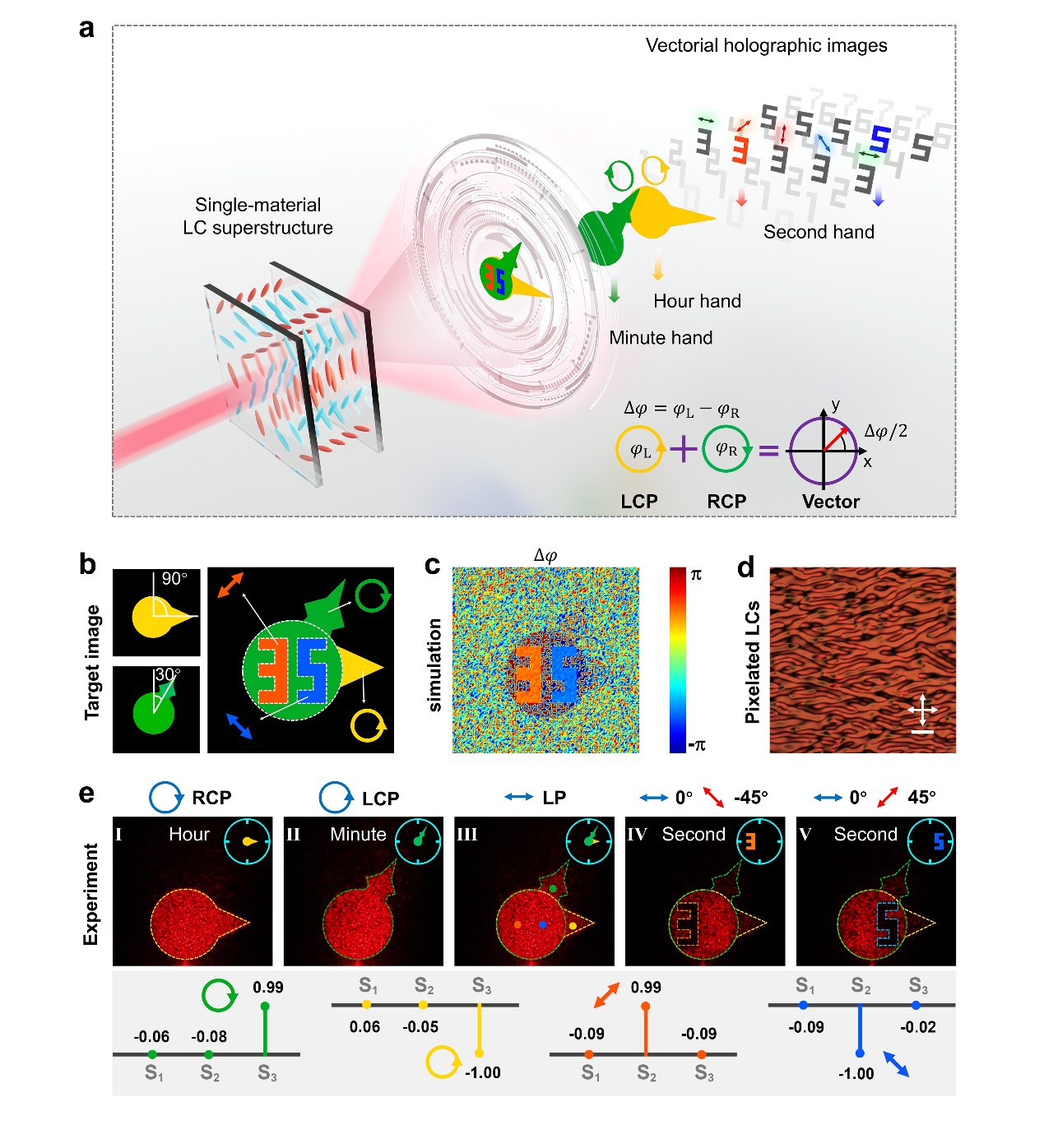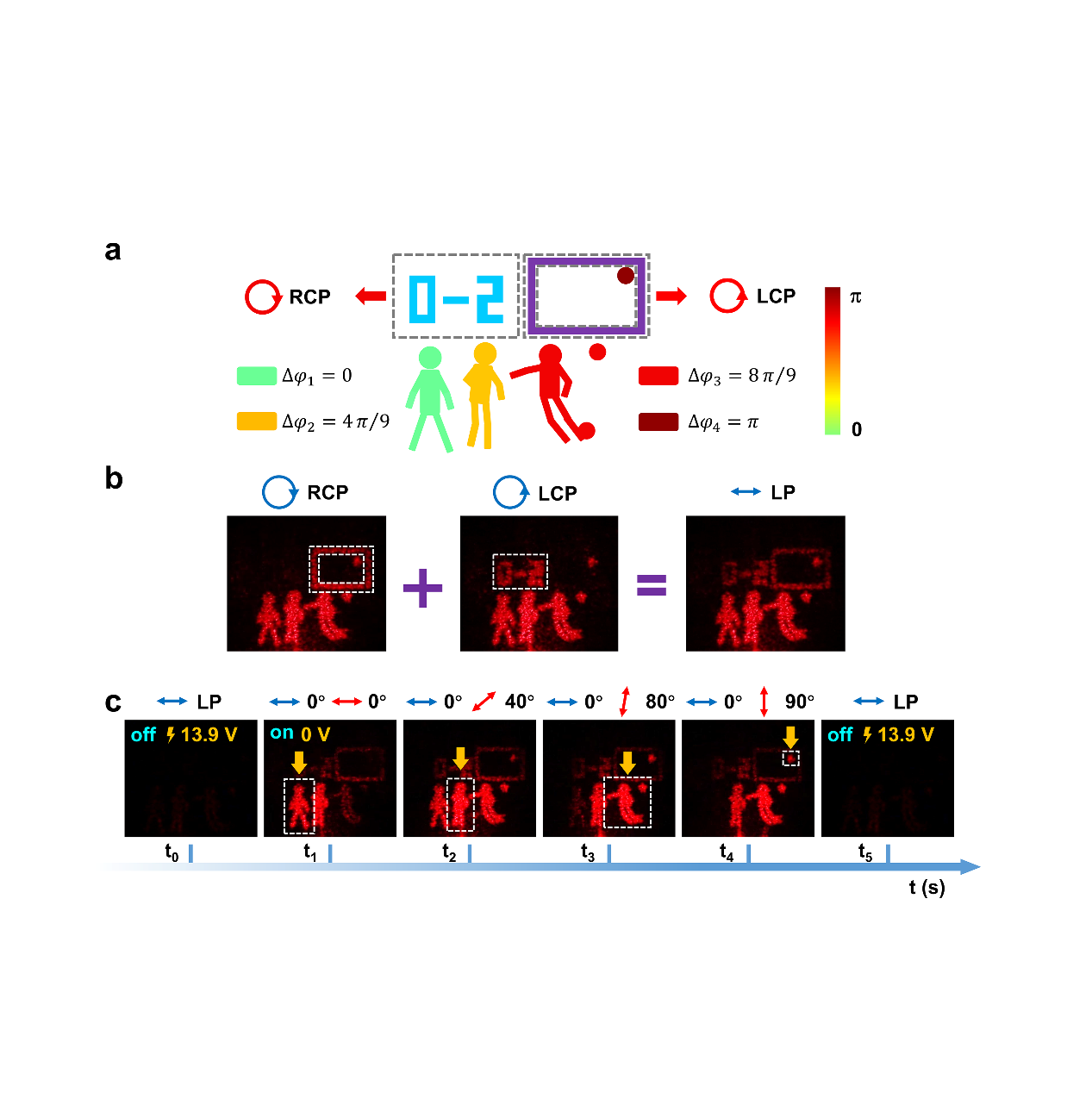Summary:
Researchers have developed a new method for controlling the polarization of light that could lead to advances in cryptography, imaging, and other fields. This method uses liquid crystals to create holograms enabling the manipulation of vectorial field at different points. This is a significant improvement over existing methods, which are limited to uniform polarization modulation or static functionalities. This finding could be used to create more secure encryption methods, higher-resolution images, and other new applications. This work is published in eLight titled “Vectorial liquid-crystal holography”【eLight 4, 5 (2024)】.
Main text:
Researchers have made a significant breakthrough in controlling the polarization of light, a crucial property for various applications such as augmented reality, data storage, and encryption. The new method, developed by a team of scientists, utilizes liquid crystals (LCs) to create holograms that can manipulate the polarization of light at different points. This represents a significant advancement over existing methods.
The traditional approach to vectorial holography, which involves manipulating both the polarization and intensity of light, often relies on metasurfaces – structures engineered to control light waves. However, these metasurfaces are static and lack the flexibility needed for dynamic photonic applications.
This new method ( https://doi.org/10.1186/s43593-024-00061-x ) overcomes this limitation by employing a single layer of LCs. LCs are known for their ability to change their properties under an electric field, making them ideal for dynamic control. The researchers developed a novel encoding method that allows LCs to display versatile and tunable vectorial holography, where both polarization and amplitude can be controlled independently at different positions.
This innovation has the potential to revolutionize various fields. For instance, it could lead to more secure encryption methods by enabling the creation of complex, dynamic holograms that are difficult to replicate. Additionally, it could pave the way for higher-resolution displays and even active holographic video projections.
The research team is optimistic about the real-world impact of their work. They believe that this novel method, requiring no complex fabrication processes, could readily be integrated into existing technologies, opening exciting possibilities for the future of displays, information encryption, and metasurface applications.
This is a significant development in the field of optics, and its potential applications are vast. The researchers’ work highlights the power of combining advanced materials with innovative design techniques to achieve breakthroughs with far-reaching consequences.
Funder:
This work was supported by the National Key Research and Development Program of China (Nos. 2022YFA1405000 and 2021YFA1202000); National Natural Science Foundation of China (No. 62375119); Natural Science Foundation of Jiangsu Province (No. BK20212004); Basic Research Program of Jiangsu Province (BK20232040); Fundamental Research Funds for the Central Universities (021314380231); Young Elite Scientists Sponsorship Program by CAST (2022QNRC001).
See the article:
Wang, Ze-Yu; Zhou, Zhou; Zhang, Han; Wei, Yang; Yu, Hong-Guan; Hu, Wei; Chen, Wei; Dai, Hai-Tao; Ma, Ling-Ling*; Qiu, Cheng-Wei*; Lu, Yan-Qing*. Vectorial liquid-crystal holography. eLight 4, 5 (2024).
https://doi.org/10.1186/s43593-024-00061-x
Quick view of the images:

Figure1|Vectorial LC-holographic clock. a, LC-based vectorial holographic clock for time information encryption. b, Target holographic images for incident light with RCP, LCP, and LP. The corresponding vectorial information is denoted.c, Simulated phase difference distribution between the holographic imagesof LCP and RCP. d, POM texture of the holographic LC superstructure. Scale bar: 50 μm. e, Vectorial LC-holographic images at various input/output polarization channels. The measured Stokes parameter values of four typical regions in the LC-holographic clock image are presented at the bottom.

Figure2|Vectorial LC-holographic lunar phases encoded with independently and continuously varied polarization and amplitude distributions.a-e,Target intensity and phase difference distribution for LC superstructures (a-b) I and (d-e) II. The double-sided arrows denote typical LP states with different amplitudes at different positions. The continuously varied LPs cover the equator of the Poincaré sphere. f-s, Experimental results of vectorial holographic images reconstructed from LC superstructures I and II for incident light with different polarizations.

Figure3|Electric-field and polarization addressable vectorial LC-holographic video.a, Vectorial LC-holographic video design. The competition gate (score) is encoded with LCP (RCP). The images of time-dependent states of the foot player taking a free kick are embedded in the vectorial channels corresponding to different phase differences. b, Holographic images obtained at RCP, LCP, and LP incidence. c, Electrically switchable and time-sequential polarization-addressable LC-holographic video display. The video is switched on/off at the applied voltage of 0 V/13.9 V.

